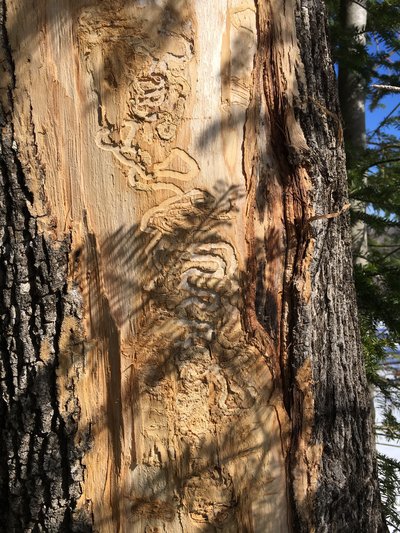Featuring Neil Monteith, Protection Forester for the Department of Forests, Parks & Recreation
13,505 days. That’s how long Forester Neil Monteith has been taking care of the woods in Vermont. His 37-year career with the Vermont Department of Forests, Parks and Recreation has included everything from fighting wildland fire to helping lead this year’s emerald ash borer (EAB) survey identification and response effort.
Neil works out of the Barre District Office as a protection forester whose main duty is to look after forest health. That’s a big job when you consider the range of activities it involves – forest disease prevention and detection, invasive species control, and wildland fire management. For that last one, he works closely with fire departments across Vermont to train their staff on wildland fire-fighting technique and teaches them how to conduct fire prevention activities, letting them borrow a Smokey Bear Suit for school presentations.
“I couldn’t ask for a better job. I get to be outside and work on so many different projects. The broad range of activities is one of the most rewarding parts. I’m not locked into any one area of forest management, I get to take a more holistic approach,” says Neil. “I also get to work with some incredible people every day. Together, all of us foresters are working on keeping Vermont’s woods healthy. It wouldn’t be possible without this team of scientists coming together to tackle these big projects.”
Rapid Response to the Emerald Ash Borer
 Neil’s EAB surveys are a key tool to evaluate the presence and spread of EAB in Vermont. Vermont was one of the last states in New England, besides Maine, to get EAB. The insect was first discovered in Michigan in 2002. It took scientists awhile to figure out what was causing the death of the ash trees. There wasn’t much information about the insect, and many were left wondering how it spread and how it got into the US. Foresters eventually figured out that the insect was hitching rides on wood products, especially firewood.
Neil’s EAB surveys are a key tool to evaluate the presence and spread of EAB in Vermont. Vermont was one of the last states in New England, besides Maine, to get EAB. The insect was first discovered in Michigan in 2002. It took scientists awhile to figure out what was causing the death of the ash trees. There wasn’t much information about the insect, and many were left wondering how it spread and how it got into the US. Foresters eventually figured out that the insect was hitching rides on wood products, especially firewood.
“Before it arrived, we began preparing a response, so we’d be ready if it did cross into our state,” Neil began. “Our team visited several other states like Massachusetts and New Hampshire to get more familiar with the insect and its effect on the forests. When it was discovered in Orange, the forester who found it sent the photographs to VTInvsaives.org. A team of us went out to the property and confirmed its presence. We’d been preparing for EAB’s arrival. Our forest health specialist, Barb Schultz, had developed a response plan back in 2011. We updated and then implemented the plan, which included the EAB road surveys to figure out how far EAB had spread in Vermont.”
The road surveys consist of a cross-agency team of people who have maps made up of square-mile grids. Each survey team drives along all the roads depicted in each grid. If the team sees an ash tree, they get out of the car and look at the ash to see if there are any symptoms of EAB.
“Typical symptoms are things like woodpecker activity. Woodpeckers will try to get at the larvae. Winter has been a great time to do the road surveys and look for symptoms of infestation. If we find evidence, we identify the location on the map. A second crew goes out to follow up on all the identified areas to verify that the trees have EAB,” Neil says.
The teams have been doing road surveys in the all the towns surrounding the original infestation in Orange to see if the insect had spread to surrounding towns. They’re nearly finished with the initial round of surveying.
Earth Day Escapes
When asked about his favorite place in the state, Neil immediately mentioned Victory Basin, located up in the Northeast Kingdom. The landscape changes from the wetlands to spruce/fir flats to northern hardwoods up to the montane forest on Burke Mountain, Kirby Mountain, and Miles Mountain. There is also the old railroad bed and other remnants from the late 19th and early 20th century logging days.
“I worked in Victory Basin for many years with the Fish and Wildlife Department. It’s an incredible place. One minute, you’re up on a mountain and the next you’re down the hill in the bog. I’ve been out there in every season to collect data, map the natural communities, and come up with strategies for managing plant life. It’s a truly unique place. There’s a giant wetland in the basin that acts like a big sink. It’s surrounded by mountains and several different watersheds feed into the basin. And, nestled in the bottom of the basin is the meandering Moose River.”
This Earth Day, it’s comforting to know that the state is in good hands with tree doctors like Neil walking the woods, looking out for Vermont’s natural communities.
Photo taken in 2016 by Tom Rogers during a prescribed burn at Victory Basin Wildlife Managment Area at a site called Lee Field. Neil is walking around the burn area perimeter as the burn progresses and making sure the burn has not escaped past the line or perimeter.
